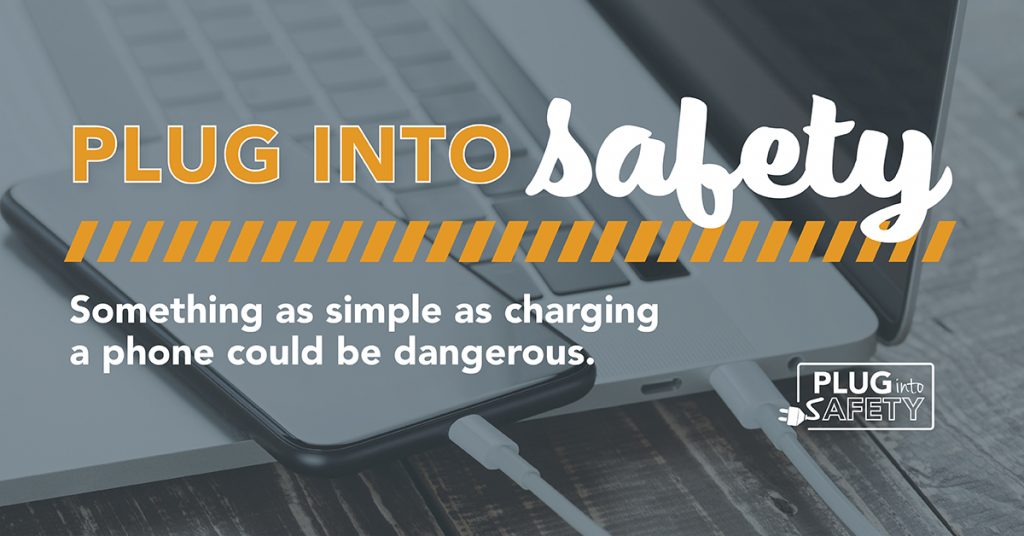
Charging a cell phone is something we all do every day. No big deal, right.
Wrong.
Take these familiar scenarios, for example:
- You need a new charger. So, you head to the nearest gas station and grab one at a discounted price.
- You typically charge your phone in the bathroom — using an unwieldy 10-foot cord.
- You like keeping your phone close, so you plug it in next to your bed and tuck it under your pillow.
- You’ve run out of outlets, so your phone charger has taken permanent residence plugged into an extension cord.
All pose dangers. Here’s why:
Quality Cords
Whether you need a replacement or just want an extra phone charger, it can be tempting to purchase the low-priced option rather than the higher-priced charger from the manufacturer. However, purchasing a bargain charger could have disastrous consequences.
Most of the time, these products are unregulated and untested. Their components are often low quality and are not backed by a manufacturer’s warranty. Only purchase charging devices and electronics from trusted sources and be sure they have been tested or marked by a nationally recognized testing laboratory like Underwriters Laboratories.
It’s also important to inspect your charging cords for damage. Any cord that carries electrical power becomes a fire hazard when it’s damaged and wires are exposed. As soon as you see damage to a cord, stop using it.
Right Location
It’s safest to charge your devices on cool, well-ventilated surfaces away from flammable objects. A well-ventilated spot will help prevent your device from overheating. Devices tucked under a pillow, nestled on the carpet or resting on a bed or couch don’t allow for this.
And, always unplug charging cords when they’re not in use. Cords that are plugged in are constantly drawing power. If the cord isn’t plugged into a device that power can be transferred to flammable objects, such as fabric, carpet or wood, and cause it to ignite.
Water Hazard
Once your phone is plugged into an outlet it becomes a potential electrical hazard. And, unlike a hair dryer or electric razor — devices meant to be used in a bathroom — phones, laptops and wireless speakers are not equipped with a safety mechanism known as a ground-fault circuit interrupter (GFCI), which shuts off power to the device when it gets wet.
In the U.S., building codes require you to use outlets equipped with a GFCI in bathrooms, kitchens and other household spaces where an electronic device might come into contact with water. Regardless of the type of cord you’re using, if you drop your phone into water you could be electrocuted.
Extension Cords
Avoid relying on extension cords when charging devices. Extension cords are not meant for long-term use. If you need to plug in your phone in a more convenient area than is available, this may be an indicator you need more outlets.
Don’t make your electronic devices even more complicated than they already are. Always stay plugged into safety when using a device’s charging cord!
Source: ESFI, finance.yahoo.com
Debunking Five Phone Charging Myths
Never charge your phone overnight
There is no risk of you “overcharging” your phone and causing damage to the battery, as there are safeguards in place now to prevent that from happening. But you do need to worry about overheating.
Let your phone go to 0 percent before charging
Completely draining your battery before a charge causes it to become more unstable. Instead, keep your devices charged between 50 and 80 percent.
Any charger, even an off-brand model, will work
Off-brand chargers are not built with safety in mind. This means there is a far greater chance of these chargers causing a fire, or harming your battery, than there is with your phone’s proper charger.
Turning off your phone is useless
You should shut down or properly restart your device at least one a week, because this has been proven to conserve your device’s battery life over time.
Don’t use your phone while it’s plugged in
While it is safe to use your smartphone while charging it with its proper charger, it is not recommended to do it when using a third-party charger. That may lead to the phone exploding, or worse, electrocuting the user.
Source: lifehack.org
Nine Tips and Tricks to Save Your Battery
- Do not charge your phone with a charger that has different output voltage and current rating.
- Avoid using cheap chargers from unknown manufacturers.
- Consider removing the phone’s protective case while charging.
- Do not always use a “fast charger” to charge your phone to avoid overheating.
- Avoid using third-party battery apps.
- Charge your smartphone’s battery up to at least 80 percent.
- Avoid constant recharges. Allow the battery to discharge to around 20 percent before you plug it in. Constant and unnecessary recharges shorten the life of the battery.
- Buy power banks that promise protection against voltage surge, short circuit, over-current and over charging.
- Avoid using your handset while it is connected to the power bank. Using the device in this mode will increase the internal temperatures and shorten battery life.
Source: ESFI





